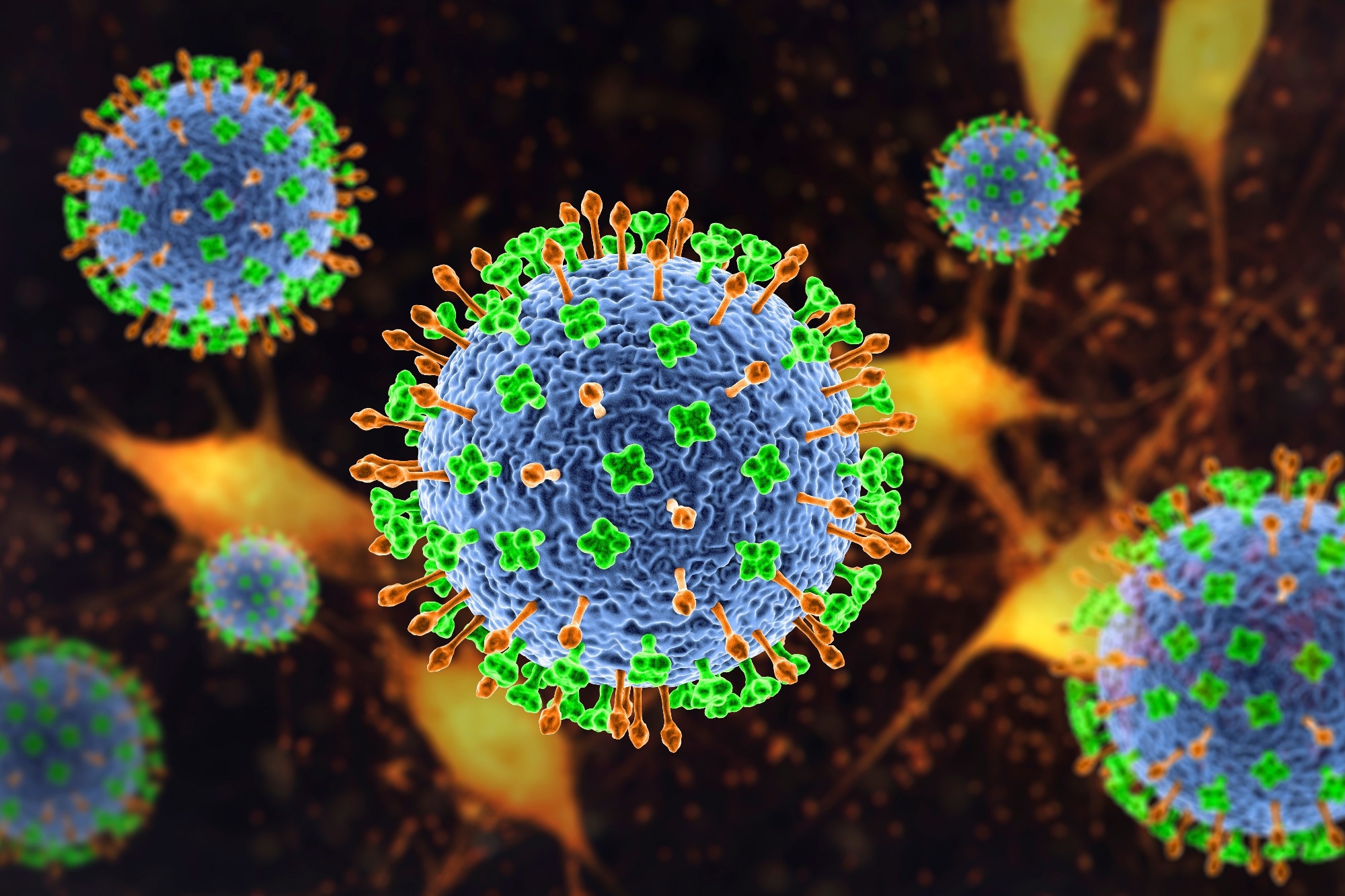In a recent study published in Scientific Reports, researchers characterized the immunogenicity and safety of poxvirus-based Nipah vaccines that can be used in humans and species responsible for Nipah virus (NiV) transmission.
 Study: Immunogenicity of poxvirus-based vaccines against Nipah virus. Image Credit: KaterynaKon/Shutterstock.com
Study: Immunogenicity of poxvirus-based vaccines against Nipah virus. Image Credit: KaterynaKon/Shutterstock.com
Background
NiV, a novel zoonotic disease in Southeast Asia, spreads from fruit bats to individuals, triggering catastrophic outbreaks. Infected bats can spread the virus to humans, horses, pigs, dogs, and cats, among other species. Infections in humans range from asymptomatic to deadly encephalitis and serious respiratory illness.
Supportive therapy and ribavirin treatment have lowered mortality in the lack of any commercially accessible NiV vaccine. Nipah virus is a priority pathogenic organism, prompting vaccine development.
Recombinant viral vectors, subunit vaccines, messenger ribonucleic acid (mRNA), and virus-like particles (VLP) platforms are examples of existing vaccine techniques that are primarily concerned with safeguarding the well-being of humans and lack a One Health-based vaccination approach.
About the study
In the present study, researchers evaluated the safety and immunogenicity of the raccoon pox (RCN)-FG and modified vaccinia Ankara (MVA)-FG vaccines that express the fusion protein (F) and glycoprotein (G) of the Nipah virus simultaneously.
AJ and BALB/c mice were vaccinated with RCN-FG and MVA-FG vaccines, respectively, to characterize the expression of the recombinant viral organisms in vitro and quantify their immune responses. A booster vaccine was administered after four weeks of the prime vaccine.
Three weeks post-booster dose, murine sera were obtained, and a week later, lung and spleen cells and bronchoalveolar lavage (BAL) fluid were obtained.
Enzyme-linked immunosorbent assays (ELISA) and neutralization assays were performed to assess humoral responses, and flow cytometry and ELISpot interferon-gamma (IFN‑γ), interleukin-2 (IL‑2), and tumor necrosis factor-alpha (TNF‑α) assays were performed to assess cell-mediated responses.
In addition, immunofluorescence analysis was performed to determine the cellular localization and evaluate the fusion protein and glycoprotein expression in RCN-FG- and MVA-FG-infected cells, confirmed by Western blot analysis.
Mice were vaccinated subcutaneously (SC, one or two doses) and intranasally (IN, one dose) to evaluate immunogenicity. Baby hamster renal cells (BHK-21), chicken embryonic fibroblast cells (CEF), Cercopithecus aethiops (African green monkey) renal epithelium cells (Vero), and American-type culture collections (ATCC) cells were used for the cell culture experiments.
The MVA expression cassette comprised the fusion protein and glycoprotein sequences of the Nipah virus strain isolated from Bangladesh in 2004 (NiVB), and the RCN gene cassette comprised the fusion protein and glycoprotein sequences of the Nipah virus strain which was isolated during the 2018 outbreak in India.
The fusion protein and glycoprotein were combined with the human immunoglobulin G (IgG) and tissue plasminogen activator (tPA), respectively. Polymerase chain reaction (PCR)-amplified deoxyribonucleic acid (DNA) for each expression cassette was utilized to produce the recombinant viruses.
Results
Neither of the recombinant vaccines induced significant clinical signs of infection or weight loss while generating high circulating neutralizing antibodies and pulmonary IgA and IgG responses.
The MVA vaccine induced tissue-resident and effector memory (TEM) cluster of differentiation 8ɑ+ (CD8ɑ+) T lymphocytes in splenocytes and lungs in high amounts, with central memory (TCM) CD8ɑ+ T lymphocyte expression in the lungs.
The RCN vaccine generated tissue-resident (IN) and effector memory (SC) CD8ɑ+ T lymphocytes in splenocytes and tissue-residing (IN) CD8ɑ+ T lymphocytes in pulmonary tissues. The fusion protein was detected in permeabilized and non-permeabilized MVA-FG-infected CEF cells, whereas the glycoprotein was detected intracellularly in MVA-FG-infected cells.
The fusion protein and glycoprotein were detected on the cell surfaces and intracellularly for the raccoon pox virus. The IN group consistently induced higher anti-F antibody titers at all time points (weeks 3.0, 5.0, and 7.0) than the other groups.
Anti-G titers induced in the murine animals vaccinated with the recombinant vaccines were higher than anti-F titers. No anti-F antibodies were detected in the respiratory tissues of MVA-FG IN-vaccinated animals.
MVA-FG produced the greatest number of circulating antibodies when delivered SC; however, IN produced the greatest morphological expression of effector, tissue-resident, and central CD8+ T lymphocytes in both lung cells and splenocytes.
The raccoon pox vaccine elicited effector and tissue-resident CD8+ T lymphocytes in lung cells and splenocytes through In and SC routes, confirming oral immunization as a method of stimulating the immune system with this vaccine.
Conclusions
Based on the study findings, the poxvirus-based vaccines employed to transport the NiV fusion protein and glycoprotein were both effective and safe.
The findings established RCN-FG and MVA-FG viral vectors as promising vaccine candidates for protecting humans, domesticated animals, and wild animals and attenuating the global hazard of Nipah virus infections.
The RCN-FG vaccine is a potential wildlife vaccination against the Nipah virus in pigs and bats to reduce NiV transmission from wild animals to humans and prevent economic turmoil caused due to swine exports to regions lacking competent host reservoirs.
By having the capacity to immunize both animals and humans, MVA-FG is a possible One-Health vaccine option and opens the path to disease elimination.